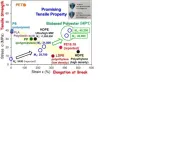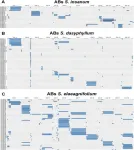(Press-News.org) Worries that surgery patients would have a tougher recovery if their doctors had to abide by a five-day limit on opioid pain medication prescriptions didn’t play out as expected, a new study finds.
Instead, patient-reported pain levels and satisfaction didn’t change at all for Michigan adults who had their appendix or gallbladder removed, a hernia repaired, a hysterectomy or other common operations after the state’s largest insurer put the limit in place, the study shows.
At the same time, the amount of opioid pain medication patients covered by that insurer received dropped immediately after the limit went into effect. On average, patients having these operations received about three fewer opioid-containing pills.
The study, which merges two statewide databases on patients covered by Blue Cross Blue Shield of Michigan (BCBSM), is the first large study to evaluate whether opioid prescribing limits change patient experience after surgery.
It’s published in JAMA Health Forum by a team from Michigan Medicine, the University of Michigan’s academic medical center.
Measuring the impact of limits from patients’ perspectives
The BCBSM limit of five days’ supply, which went into effect in early 2018, is even stricter than the seven-days’ supply limit put in place a few months later by the state of Michigan. Other major insurers and states have also implemented limits, most of which allow are seven-day limits.
Limits are designed to reduce the risk of long-term opioid use and opioid use disorder, as well as to reduce the risk of accidental overdose and the risk of unauthorized use of leftover pills.
“Opioid prescribing limits are now everywhere, so understanding their effects is crucial,” said Kao-Ping Chua, M.D., Ph.D., the study’s lead author. “We know these limits can reduce opioid prescribing, but it hasn’t been clear until now whether they can do so without worsening patient experience.”
He noted that even the 15% of patients who had been taking opioids for other reasons before having their operations didn’t show an increase in pain or a decrease in satisfaction after the limit was put in place, even though opioid prescribing for these patients decreased. That decrease was actually contrary to the intent of the limit, which was only designed to reduce prescribing to patients who hadn’t taken opioids recently.
Chua and several of his co-authors belong to the U-M Opioid Research Institute and Institute for Healthcare Policy and Innovation. In addition to his work on opioids, Chua is an assistant professor of pediatrics at the U-M Medical School and a member of the Susan B. Meister Child Health Evaluation and Research Center at U-M.
Some of the authors helped develop evidence-based surgical opioid prescribing guidelines published by U-M’s Opioid Prescribing Engagement Network (OPEN), a group that recommends prioritizing non-opioid pain relief and limiting prescriptions to no more than 10 opioid pills for most of the operations considered in the study.
How the study was done
For the new study, Chua and colleagues used data from the Michigan Surgical Quality Collaborative, which collects data on patients having common operations at 70 Michigan hospitals.
Funded by BCBSM as a collaborative quality initiative under its Value Partnerships effort, MSQC surveys patients about their pain, level of satisfaction and level of regret after their operations.
The team paired anonymized MSQC data with data on controlled substance prescription fills from the state’s prescription drug monitoring program, called MAPS.
In all, they were able to look at opioid prescribing and patient experience data from 1,323 BCBSM patients who had common operations in the 13 months before the five-day limit went into effect, and 4,722 patients who had operations in the 20 months after the limit went into effect.
About 86% of both groups were non-Hispanic white, patients’ average age was just under 49, and just under a quarter of both groups had their operations on an emergency or urgent basis. Just under half were admitted to the hospital for at least one night.
About 27% of both groups had their gallbladders taken out laparoscopically, and a similar percentage had minor hernia repairs. About 10% had an appendectomy done laparoscopically, and a similar percentage had laparoscopic hysterectomies. The rest had more invasive procedures, like open hysterectomies major hernia repairs, or colon removal.
The percentage of prescribers who prescribed opioids to their patients having these operations did not change, but the percentage of patients who filled a prescription for an opioid did, possibly because pharmacists rejected prescriptions that weren’t compliant with the BCBSM limit, Chua speculates.
Jennifer Waljee, M.D., M.P.H., M.S., senior author of the study, notes that the MSQC database doesn’t include all types of procedures, such as knee replacements and spine surgery, which typically require larger postoperative opioid prescriptions because of their associated pain.
She indicated that it’s important to understand the impact of opioid prescribing limits on the experiences of such patients, because limits have the most potential to worsen pain for these individuals.
“Opioid prescribing limits may not worsen patient experience for common, less-invasive procedures like those we studied, because opioid prescriptions for most of these procedures were already under the maximum allowed by limits. But this may not be the case for painful operations where opioid prescribing was suddenly cut from an 8- to 10-day supply to a 5-day supply,” said Waljee, an associate professor of surgery at the Medical School and director of the U-M Center for Healthcare Outcomes & Policy.
She added, “The message of this study is not that we can simply go to five days’ supply across the board for operations. We need to understand the effects of these limits across a broad range of procedures and patients given how much pain needs vary in order to right size prescribing to patient need without resulting in additional harms.”
END
Opioid limits didn’t change surgery patients’ experience, study shows
Five-day limit from Michigan’s largest insurance company didn’t lead to increases in patients’ pain levels or decrease in satisfaction after common surgical procedures
2023-10-13
ELSE PRESS RELEASES FROM THIS DATE:
Health insurance and differences in infant mortality rates
2023-10-13
About The Study: In this study of more than 13 million infants, maternal Medicaid insurance was associated with increased risk of infant mortality at the population level in the U.S. Novel strategies are needed to improve access to care, quality of care, and outcomes among women and infants enrolled in Medicaid.
Authors: Colm P. Travers, M.D., of the University of Alabama at Birmingham, is the corresponding author.
To access the embargoed study: Visit our For The Media website at this link https://media.jamanetwork.com/
(doi:10.1001/jamanetworkopen.2023.37690)
Editor’s ...
County-level social vulnerability, metropolitan status, and availability of home health services
2023-10-13
About The Study: This study found differences in Medicare-funded home-based clinical care provision across the U.S. by county-level Social Vulnerability Index (a measure of socioeconomic deprivation), suggesting inequitable care access among homebound Medicare beneficiaries. Almost one-quarter of counties had low availability of home-based medical care clinicians coupled with high socioeconomic disadvantage.
Authors: Harriet Mather, M.D., of the Icahn School of Medicine at Mount Sinai in New York, is the corresponding author.
To access ...
Sustainability presents huge opportunities for business and financial institutions
2023-10-13
Why does sustainability matter for businesses and financial institutions? For centuries, competitive markets have been drivers for growth and improvement of quality of life. It is paramount to ensure these markets are compatible with sustainability and can adequately mitigate and adapt to climate change. These changes require a significant amount of capital, and knowledgeable investment and business professionals to deploy it
Sustainability: Business and Investment Implications explores the opportunities and challenges presented by sustainability, the energy transition and the decarbonization of the economy. Over the past years, the United Nations and global ...
New biobased recyclable polyesters exhibiting excellent tensile properties beyond polyethylene and polypropylene
2023-10-13
The research group of Professor Kotohiro Nomura, Tokyo Metropolitan University, in cooperation with the research group of Director Hiroshi Hirano, Osaka Research Institute of Industrial Science and Technology, has developed biobased polyesters from inedible plant resources, which can be easily chemical recyclable and exhibit promising mechanical properties in film than commodity plastics.
The development of high-performance sustainable, recyclable plastics is an important subject to realize circular economy. Biobased polyesters made from plant resources are expected to become promising alternative materials to polymers such ...
Immune system ageing can be revealed by CT scan
2023-10-13
Thymus, a small and relatively unknown organ, may play a bigger role in the immune system of adults than was previously believed. With age, the glandular tissue in the thymus is replaced by fat, but, according to a new study from Linköping University (LiU) in Sweden, the rate at which this happens is linked to sex, age and lifestyle factors. These findings also indicate that the appearance of the thymus reflects the ageing of the immune system.
“We doctors can assess the appearance of the thymus from largely all chest CT scans, ...
Physicists demonstrate powerful physics phenomenon
2023-10-13
COLUMBUS, Ohio – In a new breakthrough, researchers have used a novel technique to confirm a previously undetected physics phenomenon that could be used to improve data storage in the next generation of computer devices.
Spintronic memories, like those used in some high-tech computers and satellites, use magnetic states generated by an electron’s intrinsic angular momentum to store and read information. Depending on its physical motion, an electron’s spin produces a magnetic current. Known as the “spin Hall effect,” this has key applications ...
Exploring the genetic potential of eggplant's wild relatives for sustainable agriculture
2023-10-13
In the pursuit of sustainable agriculture, enhancing nitrogen use efficiency (NUE) in crops stands as a primary objective. With the prolific use of nitrogen (N) fertilizers since the 20th century, agricultural productivity has seen remarkable growth. However, excessive use of N fertilizers has resulted in serious environmental threats and energy consumption. Crop wild relatives (CWR) provide valuable genetic resources to address this issue through breeding programs. Wild relatives of eggplant (Solanum melongena L.) are classified into primary (GP1), ...
Cleaner snow boosts future snowpack predictions
2023-10-13
RICHLAND, Wash.—Less pollution settling into snow should help cut the decline of snowpack in the Northern Hemisphere later this century. Though the snowpack will still diminish due to rising temperatures, the outlook is less dire when the cleaner snow of the future is considered.
In some scenarios, the researchers predict that the reduction in snowpack will be less than half what has been predicted—good news for the many people who rely on subsequent snowmelt in high mountains for water and food production, as well as for those who depend on winter recreation.
The ...
American Academy of Pediatrics hosts 2023 National Conference & Exhibition in Washington, D.C.
2023-10-13
Media Contacts: Lisa Black, lblack@aap.org, 630-626-6084
Adam Alexander, aalexander@aap.org, 630- 626-6765
Jamie Poslosky, jposlosky@aap.org, 202-724-3301
Devin Mazziotti, dmazziotti@aap.org, 202-724-3308
WASHINGTON, DC – The 2023 American Academy of Pediatrics (AAP) National Conference & Exhibition presents exciting new research and policies concerning children’s health this year in the nation’s capital, where more than 10,000 pediatric medical professionals will arrive from across the country and world.
The conference, held Oct. 20-24, 2023, at the Walter E. Washington Convention Center in Washington, ...
New South American site reveals extraordinary fossils from the end of the age of the dinosaurs
2023-10-13
Release No. 23-35
Contact: Justin Samuel
+1-303-357-1026
jsamuel@geosociety.org
Contributed by Emily Zawacki
Pittsburgh, Pa., USA: The discovery of a spectacular fossil site in Argentina is helping shed new light on life at the end of the Cretaceous, the time period just before the non-avian dinosaurs went extinct. New research presented this Monday at the Geological Society of America’s GSA Connects 2023 meeting by Matthew Lamanna, a paleontologist and the principal dinosaur researcher at Carnegie Museum of Natural History, describes exciting fossil finds from a site known as the Cañadón Tomás Quarry ...
LAST 30 PRESS RELEASES:
Numbers in our sights affect how we perceive space
SIMJ announces global collaborative book project in commemoration of its 75th anniversary
Air pollution exposure and birth weight
Obstructive sleep apnea risk and mental health conditions among older adults
How talking slows eye movements behind the wheel
The Ceramic Society of Japan’s Oxoate Ceramics Research Association launches new international book project
Heart-brain connection: international study reveals the role of the vagus nerve in keeping the heart young
Researchers identify Rb1 as a predictive biomarker for a new therapeutic strategy in some breast cancers
Survey reveals ethical gaps slowing AI adoption in pediatric surgery
Stimulant ADHD medications work differently than thought
AI overestimates how smart people are, according to HSE economists
HSE researchers create genome-wide map of quadruplexes
Scientists boost cell "powerhouses" to burn more calories
Automatic label checking: The missing step in making reliable medical AI
Low daily alcohol intake linked to 50% heightened mouth cancer risk in India
American Meteorological Society announces Rick Spinrad as 2026 President-Elect
Biomass-based carbon capture spotlighted in newly released global climate webinar recording
Illuminating invisible nano pollutants: advanced bioimaging tracks the full journey of emerging nanoscale contaminants in living systems
How does age affect recovery from spinal cord injury?
Novel AI tool offers prognosis for patients with head and neck cancer
Fathers’ microplastic exposure tied to their children’s metabolic problems
Research validates laboratory model for studying high-grade serous ovarian cancer
SIR 2026 delivers transformative breakthroughs in minimally invasive medicine to improve patient care
Stem Cell Reports most downloaded papers of 2025 highlight the breadth and impact of stem cell research
Oxford-led study estimates NHS spends around 3% of its primary and secondary care budget on the health impacts of heat and cold in England
A researcher’s long quest leads to a smart composite breakthrough
Urban wild bees act as “microbial sensors” of city health.
New study finds where you live affects recovery after a hip fracture
Forecasting the impact of fully automated vehicle adoption on US road traffic injuries
Alcohol-related hospitalizations from 2016 to 2022
[Press-News.org] Opioid limits didn’t change surgery patients’ experience, study showsFive-day limit from Michigan’s largest insurance company didn’t lead to increases in patients’ pain levels or decrease in satisfaction after common surgical procedures




